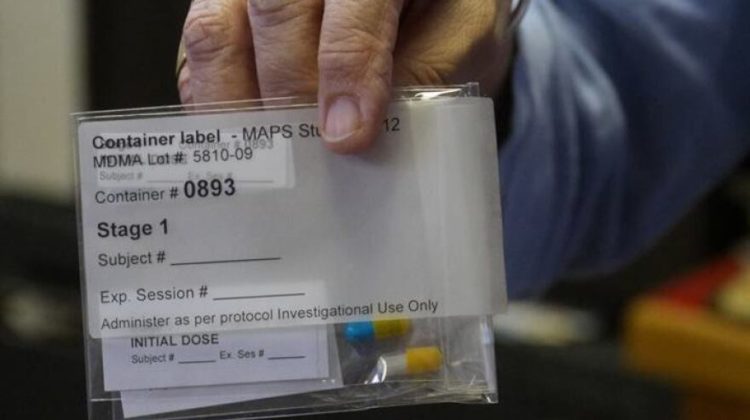
Use of MDMA pills for studies. Photo credit: Multidisciplinary Association for Psychedelic Studies (MAPS).
Researchers are finding more evidence that MDMA may treat some of the world’s most common conditions, including depression and anxiety disorders.
MDMA is currently a schedule I drug, meaning it has a high potential for abuse and no medical use. However, that may soon change as researchers explore its ability to treat a variety of conditions.
For example, last year, the Multidisciplinary Association for Psychedelic Studies (MAPS) announced on their official Twitter page that the federal Food and Drug Administration (FDA) granted approval for their MDMA-assisted therapy clinical trials.
As MAPS found, MDMA can decrease feelings of fear and defensiveness, and increase feelings of wellbeing, sociability and extroversion, interpersonal trust, and an alert state of consciousness. Due to such effects, MDMA shows promise in treating depression.
The World Health Organization (WHO) states, “depression is a common illness worldwide, with an estimated 3.8% of the population affected, including 5.0% among adults and 5.7% among adults older than 60 years. Approximately 280 million people in the world have depression.”
Additionally, the WHO reports, it is the leading cause of disability worldwide. It is characterized by feelings of sadness, irritability, emptiness, and loss of pleasure or interest in activities. It can range from mild to severe.
Depression has similar symptoms as PTSD, such as sleeping problems or negative thoughts. In one MAPS’ study involving MDMA, researchers found that MDMA helped relieve some of these symptoms. More specifically, the study reported that, “67% of participants with severe PTSD no longer met PTSD diagnostic criteria two months after their third session of MDMA-assisted therapy, compared to 32% of placebo participants.”
MDMA’s Origin
While MDMA is finding new applications in therapy, the substance or its efficacy is not new to researchers.
A chemist discovered MDMA more than 100 years ago. According to the Substance Abuse and Rehabilitation journal, in 1912, Anton Kollisch — a worker at German pharmaceutical company, Merck — accidently discovered it. Merck patented it, but the company did not find any medical properties of interest.
It was decades before interest in the drug developed further. According to History, in the 1950s “during the Cold War both the U.S. Army and the CIA experimented with MDMA and other hallucinogenic drugs as weapons.”
But in 1978, Alexander Shulgin conducted a study with Dr. David Nichols on the effects of MDMA and found it had benefits in therapy, according to the Addiction journal. Other researchers and psychotherapists then explored its therapeutic use.
By the 1980s, MDMA became popular for recreational uses as ecstasy. In 1984, the Drug Enforcement Agency (DEA) made an announcement to declare it as a schedule I drug and researchers called for a hearing on its scheduling. According to the book Ecstasy: The MDMA Story by Bruce Eisner, in 1985, researchers appealed to make it a schedule III substance as it had therapeutic potential and didn’t have a high abuse potential. However, despite their efforts, the DEA still banned it. Officials have classified it as a schedule I drug since then.
MDMA and Medical Uses
In a study led by Marcela Ot’alora, researchers observed the effects of MDMA while conducting psychotherapy on 28 participants with PTSD that had previously attempted psychotherapy.
Among these participants, 12 were diagnosed with major depressive disorder (MDD) while seven were diagnosed with depression. Participants were randomly given 40, 100, or 125 mg of MDMA in two 8-hour-long sessions that were a month apart. In a third session, researchers gave 100 or 125 mg to participants. After a year, a follow-up session was done.
The results are as follows:
“The majority (76%) did not meet PTSD diagnostic criteria, demonstrating enduring positive effects of MDMA-assisted psychotherapy. Analysis of secondary outcomes also found significant improvement at the 12-month follow-up compared to baseline for depression […], sleep quality […], and dissociation […], indicating sustained gains well after the active treatment period ended.”
Another study in the journal Nature, notes that those with life-threatening illnesses experience symptoms similar to those of PTSD. They may even develop PTSD when doctors diagnose them with a life-threatening illness or they receive treatment for one. Researchers aimed to use MDMA to treat these symptoms.
Researchers randomly gave the study’s participants a placebo or MDMA. After two sessions, those that received MDMA during psychotherapy showed greater decreases in anxiety than the placebo group. Other symptoms that were improved include depression, sleep quality, and overall well-being.
Effects on the Brain
According to separate research in the journal Nature, Felix Müller conducted a study with 45 participants. Researchers gave those participants 125 mg doses of MDMA. Then, the participants underwent an fMRI to observe the effects of MDMA on the brain. In the default mode network (DMN), a system of brain regions that are active in a state of infocus, the brains of the participants displayed decreased connectivity patterns in the brain’s neural network. Excessive connectivity, as Carl Sherman states, may be responsible for psychiatric disorders and negatively affects control over behavior.
Additionally, previous studies link depression to increased functional connectivity in the DMN.
In conclusion, the researchers pose that MDMA may destabilize neural pathways left by depression and allow new pathways to form, which could explain the long-term effects of MDMA.
Despite the reputation MDMA had, the FDA may lift the ban placed on it. When scientists complete the ongoing clinical trials, affirming its safety and medical properties, patients with depression or other disorders, such as PTSD, can then officially use it as treatment.



Leave a Reply